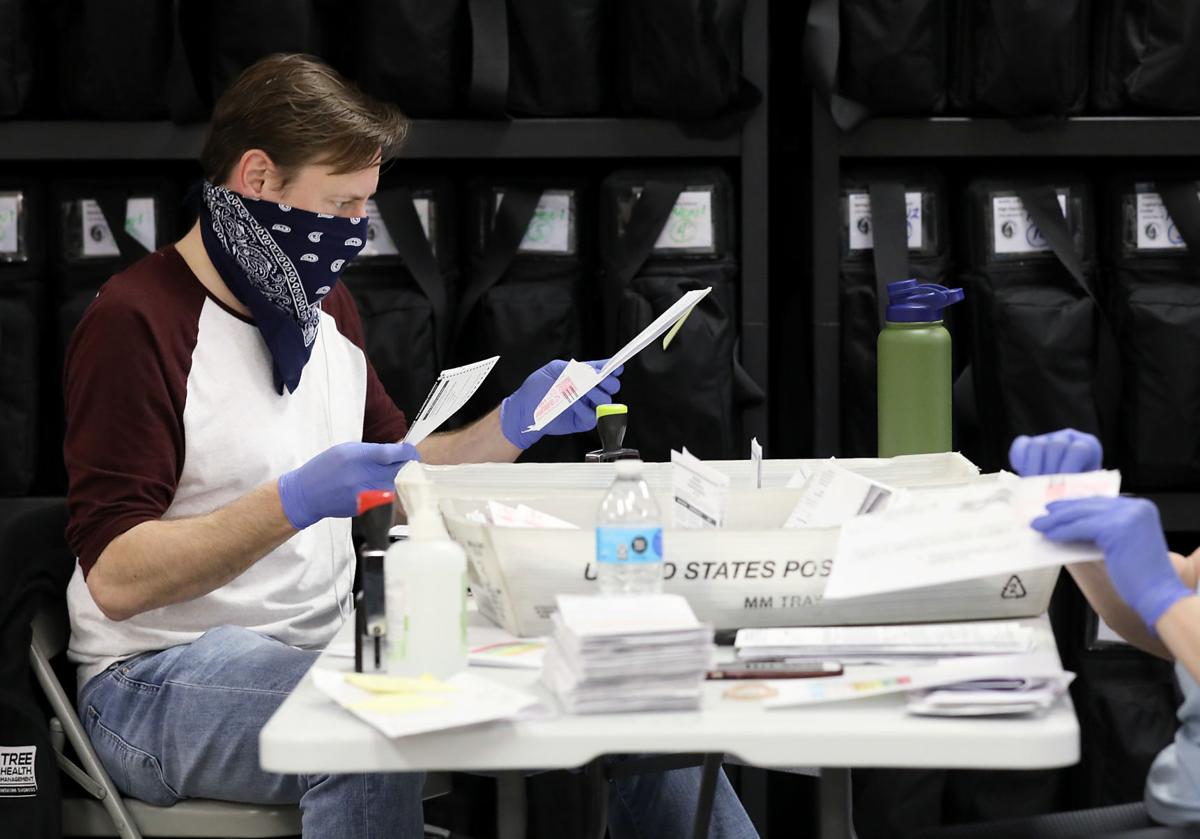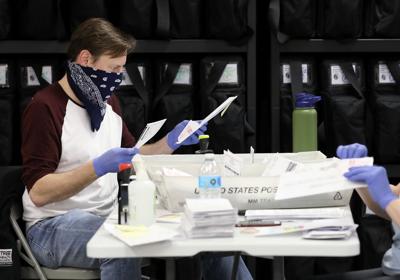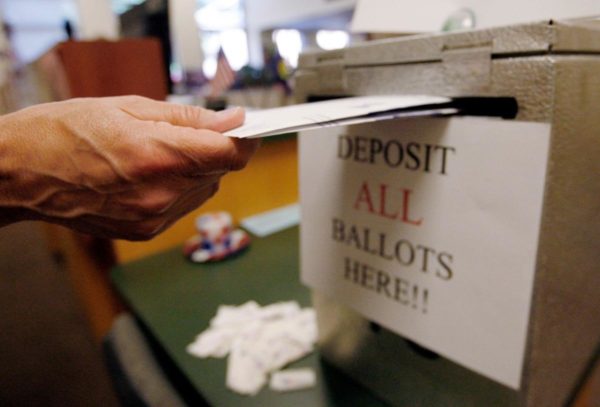Wisconsin absentee ballots may pose issues for 2020 election

Ben Ratliffe opens envelopes with absentee ballots in a Madison City Clerk office space as the city and others across Wisconsin tallied the results of the Spring Election on April 13.
AMBER ARNOLD, STATE JOURNAL
For months, President Donald Trump has alleged without evidence that any expansion of mail-in voting in the 2020 election will lead to “tremendous” fraud and a “rigged” election.
But an APM Reports analysis of voter data from Wisconsin’s April primary shows a far more measurable and consequential effect of mail-in voting — rejected ballots. Slightly more than 23,000 ballots were thrown out, mostly because those voters or their witnesses missed at least one line on a form.
The figure is close to Trump’s 2016 margin of victory in Wisconsin of 22,748 votes. And with voter turnout expected to double from April to more than 3 million in November, a proportionate volume of absentee ballot rejections could be the difference in who wins the swing state — and possibly the presidency.
The analysis shows the difficulty some voters had casting a ballot through the mail, often for the first time.
For an absentee ballot to count in Wisconsin, a voter and a witness must sign the ballot envelope and include the address of the witness. Those safeguards — put in place to eliminate mail-in ballot fraud — contributed to the rejection of 13,834 ballots, according to APM Reports’ analysis.
Election experts say people in states like Wisconsin that traditionally have low by-mail voting rates are more prone to make errors.
“You’re asking folks to do something new,” said Michael McDonald, a political science professor and voter data expert at the University of Florida. “And whenever you try to do something new in the midst of unprecedented demand, you’re going to have problems.”
Nationally more than 300,000 absentee ballots were rejected in the 2016 presidential election, according to the U.S. Election Assistance Commission. But that number is likely to grow in November as election officials and public health experts encourage by-mail voting to reduce the spread of the coronavirus. The anticipated surge will come in an election already expected to have heavy turnout nationwide.
“We could easily see a million or more ballots being rejected because of some deficiency of the ballot,” McDonald predicted.
‘No excuse’ state
Wisconsin is among 29 “no excuse” states, plus the District of Columbia, that allow residents to vote absentee for any reason. Another five states send ballots to all registered voters without requiring a request for one.
APM Reports, the investigative and documentary journalism team at American Public Media, and Wisconsin Watch analyzed Wisconsin’s experience because the state is vital to Trump’s reelection efforts and was one of the first to hold an in-person primary as the nation shut down. The state also has traditionally low vote-by-mail participation.
The analysis serves as a case study of what may lie ahead for presidential battleground states overwhelmed by applications and without the experience or systems to cope. Other such states, including Georgia and Pennsylvania, saw problems managing increased absentee balloting in their primaries.
In the 2016 and 2018 Wisconsin general elections, absentee ballots made up no more than 6% of the ballots. In April, the portion jumped to more than 60% after the state instituted its stay-at-home order.
State officials stress that the percentage of rejected ballots in the April primary is consistent with rejection rates in past elections. While the rate may be similar, raw numbers will make the difference when it comes to winning or losing an election.
APM Reports and Wisconsin Watch requested the names of voters whose ballots were rejected in the April primary, the 2018 general election and the 2016 primary and general elections. Rejections are important to understand because voters may make a mistake, receive no notification and not be given an opportunity to fix the problem.
James Moses of Salem Lakes, Wisconsin, said he was never notified that absentee ballots he cast in multiple elections were rejected.
Moses said he voted absentee in April because he had shoulder surgery and could not drive. APM Reports filed an open records request to view his April ballot envelope. It was rejected because his wife, who witnessed Moses fill out the ballot and put it in the envelope, did not list their address on the certificate envelope. Wisconsin requires the voter and a witness to sign the ballot envelope. It also requires the witness to fill out an address.
Moses said the rejections make him distrustful of voting by mail. Next time he plans to vote in person “no matter what it takes.”
Salem Lakes clerk Shannon Hahn says she tried to contact voters who did not properly fill out the form.
“We acted like detectives trying to find and get a hold of these people,” she said. “We would have much more rejections if it wasn’t for us contacting people.”
Hahn went above and beyond. Wisconsin law does not require election officials to contact voters if they find a problem with an absentee ballot, which is similar to roughly 35 states.
State adjusts for Nov. 3
Wisconsin’s April 7 election was chaotic. There were political and legal fights over whether the election should be delayed. The U.S. Postal Service failed to deliver hundreds of ballots. And competing legal rulings created uncertainty over which guidelines voters and clerks had to follow when it came to absentee balloting.
State election officials have taken steps to ensure a better process for the August primary and the November general election. They have changed the computer system to help municipal clerks process absentee ballot applications. They are putting barcodes on mailings to help voters and officials track their ballots. And they are hoping the courts make early decisions on which rules to follow.
“I certainly hope that we can get the rules down straight so everybody knows what they are, so they’re not changing very close to the deadline,” said Reid Magney, spokesman for the Wisconsin Elections Commission.
Magney said the commission also will mail absentee ballot applications to every registered voter in September to help local elections officials.
Attorneys representing Democrats have pushed to loosen the restrictions on mail-in voting in at least 13 states including Wisconsin.
Although studies show that younger voters and minority voters tend to have their ballots rejected at a higher rate than older, white voters, McDonald says he is not certain that will continue — especially if mail delivery slows in rural communities that traditionally back Republican candidates.
“These rejected absentee ballots tend to break toward the Democrats,” McDonald said. “I don’t think anyone knows how these ballots will break for November, because there’s so many different moving parts.”
High turnout cities affected
A typically high voter participation rate, combined with small city staff in an area that is not used to voting by mail, are ingredients for a spike in ballot rejection.
Consider the city of Cedarburg.
Residents of this community of 11,500 people north of Milwaukee take voting seriously — more than 80% of the voting age population cast ballots in the past two presidential elections. That is more than 13 points higher than the state average. But nearly all those voters voted in person.
That changed with the pandemic. More than 60% of Cedarburg voters cast absentee ballots, compared to 7% in 2018.
“We were just inundated,” said Tracie Sette, Cedarburg’s city clerk. “It was all we could do to just keep up with the requests.”
The increase also brought a surge in ballot rejections.
In April, Cedarburg had both a relatively high number of rejected ballots (209) and rate of rejected ballots (7%), according to Wisconsin Elections Commission data. Comparatively, just three ballots were rejected in the 2016 presidential primary and the 2016 and 2018 general elections.
Bob and Jan Capen voted absentee for the first time in the April election. The couple signed their names as witnesses to each other’s ballots and mailed them in. Neither of their votes counted.
Their ballots were marked as “certification insufficient,” the most common reason cited for the 23,196 absentee ballots rejected in April. Copies of the Capens’ ballot envelopes show they both missed the yellow-highlighted line that required their addresses as witnesses.
“It’s my fault,” Bob Capen said. “But based on what I’ve learned so far, it’s not an easy process for a lot of people, so I can see how it could get all clustered up.”
Diane Coenen, president of the Wisconsin Municipal Clerks Association, said first-time absentee voters can be confused by the ballot envelope, which displays a lot of information and requires attention to detail. Most people do not read it from top to bottom, Coenen said, “And if they miss something, the ballot will be rejected.”
Rykki Casey of Cedarburg is a health care worker who voted absentee because she takes care of elderly and hospice patients. “I didn’t want to spread (illness) to them,” she said.
Casey was confused about why her vote did not count. Her husband witnessed her ballot, but a copy of the ballot envelope showed that he, too, missed the line for his address. “I feel very sad. I want my voice heard,” she said.
Sette says she tried to contact voters to tell them about the problems with the ballot envelopes in April but stopped when she and her two colleagues became overwhelmed. She aims to contact voters if she finds problems with their ballots before the August and November elections.
“We’re getting probably about 15 to 20 ballots back every day now,” Sette said. “And every single day, there is a little stack that is missing some information.”
Public relations campaign
The Wisconsin Elections Commission is preparing a public relations campaign in the next few weeks to remind voters how to cast a mail-in ballot.
The commission reported in late July that more than 700,000 absentee ballots have been sent to voters for the August primary — 10 times the number of ballots sent in the August 2016 primary. That should free up time for clerks to contact voters.
“Our hope is that we will have enough time to be able to communicate with voters,” said Magney of the state’s election commission, “and for them to be able to communicate back and handle this process.”









